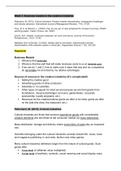Samenvatting
Samenvatting Theories of Entrepreneurship and Management in the Creative Industries 6314M0212Y
- Instelling
- Universiteit Van Amsterdam (UvA)
Samenvatting Theories of Entrepreneurship and Management in the Creative Industries 6314M0212Y Grade: 8.5
[Meer zien]




